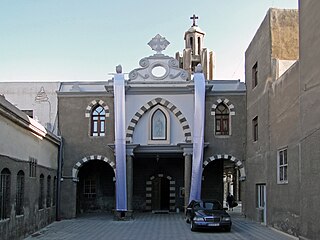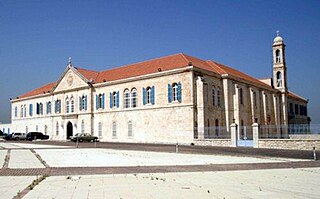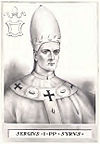
The Syriac Catholic Church is an Eastern Catholic Christian jurisdiction originating in the Levant that uses the West Syriac Rite liturgy and has many practices and rites in common with the Syriac Orthodox Church. Being one of the twenty-three Eastern Catholic Churches, the Syriac Catholic Church is a self-governed sui iuris particular church, while it is in full communion with the Holy See and with the entirety of the Roman Catholic Church.

An exarch was the holder of any of various historical offices, some of them being political or military and others being ecclesiastical.

The Melkite Greek Catholic Church, or Melkite Byzantine Catholic Church, is an Eastern Catholic church in full communion with the Holy See as part of the worldwide Catholic Church. Its chief pastor is Patriarch Youssef Absi, headquartered at the Cathedral of Our Lady of the Dormition in Damascus, Syria. The Melkites, who are Byzantine Rite Catholics, trace their history to the early Christians of Antioch, formerly part of Syria and now in Turkey, of the 1st century AD, where Christianity was introduced by Saint Peter.

The Melkite Catholic Patriarchate of Antioch is the only actual residential Patriarchate of the Melkite Greek Catholic Church. It was formed in 1724 when a portion of the Orthodox Church of Antioch went into communion with Rome, becoming an Eastern Catholic Church, while the rest of the ancient Patriarchate continues in full communion with the rest of the Eastern Orthodox Church.

The Catholic Church in Turkey is part of the worldwide Catholic Church, under the spiritual leadership of the Pope and the canonical leadership of the curia in Rome that is submitted to the Pope.

Catholics in Iraq follow several different rites, but in 2022, most (82%) are members of the Chaldean Catholic Church; about 17% belong to the Syrian Catholic Church, and the remainder are primarily Armenian, Greek and Latin-rite Catholics.

Christianity in Lebanon has a long and continuous history. Biblical Scriptures show that Peter and Paul evangelized the Phoenicians, whom they affiliated to the ancient Patriarchate of Antioch. Christianity spread slowly in Lebanon due to pagans who resisted conversion, but it ultimately spread throughout the country. Even after centuries of Muslim rule, it remains the dominant faith of the Mount Lebanon region and has substantial communities elsewhere.
The Syriac Catholic Church, established in the second half of the 17th century as an Eastern Catholic offshoot of the Syriac Orthodox Church, had around a dozen dioceses in the eastern provinces of the Ottoman Empire in the 18th and 19th centuries. Three of these dioceses were ruined during the First World War in the Assyrian and Armenian massacres, and the 20th century also saw the growth of an important Syriac Catholic diaspora in America, Europe and Australasia. As of 2012 the Syriac Catholic Church has fifteen dioceses, mostly in the Middle East, and four patriarchal vicariates for the diaspora communities.
This is a historical list of all bishops of the Catholic Church whose sees were within the present-day boundaries of the United States, with links to the bishops who consecrated them. It includes only members of the United States Conference of Catholic Bishops and their predecessors.
The Apostolic Vicariate of Beirut is a Latin Church ecclesiastical jurisdiction or apostolic vicariate of the Catholic Church in Lebanon, where Eastern Catholics are far more numerous. In 2010, there were 15,000 baptized. Its current bishop is Cesar Essayan.
The Maronite Eparchy of Latakia or Latakia of the Maronites is a Maronite Church ecclesiastical territory or eparchy of the Catholic Church in Syria. As of 2011, there were 35,000 members. The current eparch is Antoine Chbeir.
Catholic dioceses in the Holy Land and Cyprus is a multi-rite, international episcopate in Israel and Cyprus.

The Maronite Church is an Eastern Catholic sui iuris particular church in full communion with the pope and the worldwide Catholic Church, with self-governance under the Code of Canons of the Eastern Churches. The current head of the Maronite Church is Patriarch Bechara Boutros al-Rahi, who was elected in March 2011 following the resignation of Patriarch Nasrallah Boutros Sfeir. The current seat of the Maronite Patriarchate is in Bkerke, northeast of Beirut, Lebanon. Officially known as the Antiochene Syriac Maronite Church, it is part of Syriac Christianity by liturgy and heritage.














